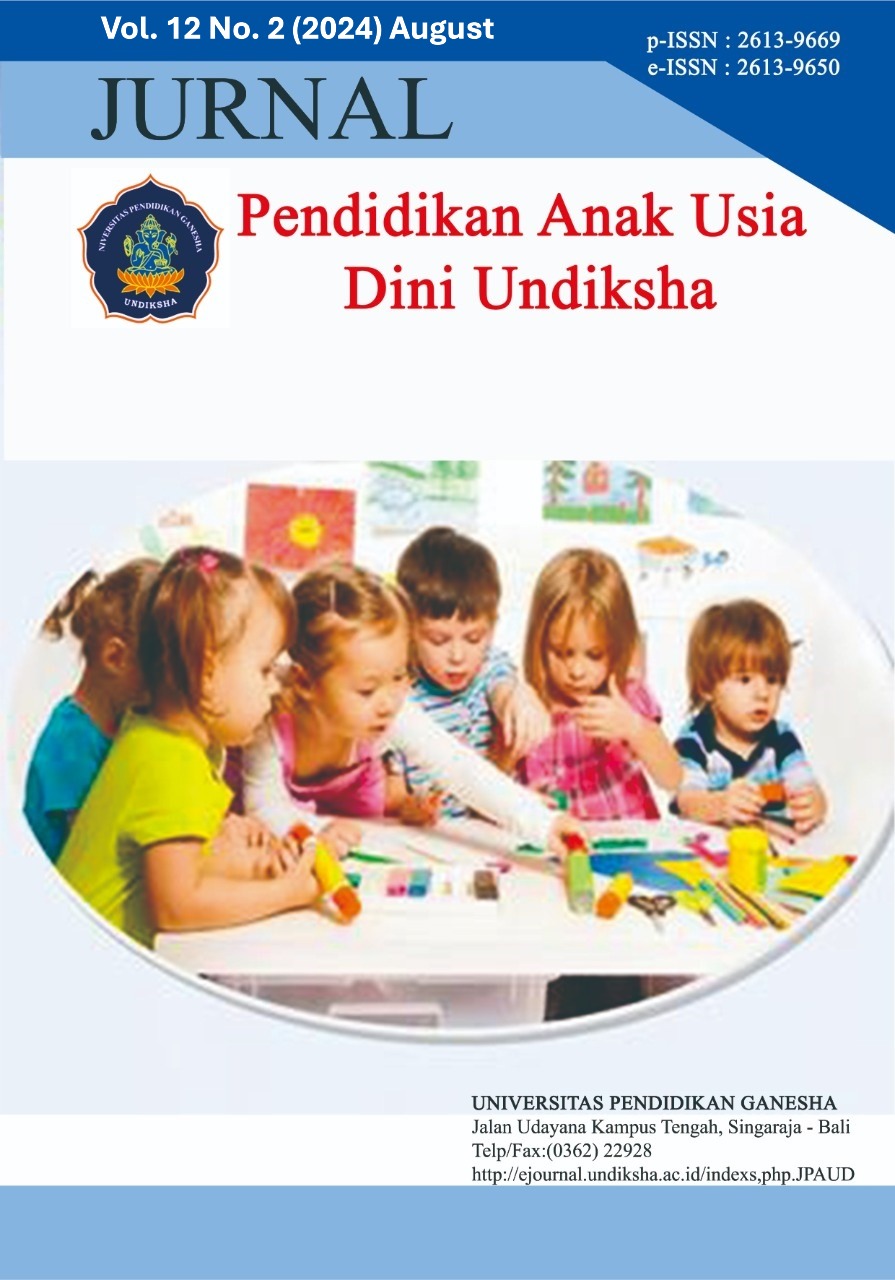Fostering Interpersonal Intelligence in Early Childhood through Traditional Gobak Sodor Game
DOI:
https://doi.org/10.23887/paud.v12i2.71797Keywords:
Gobak Sodor, Interpersonal Intelligence, ChildrenAbstract
The golden age of early childhood is a crucial period for developing multiple intelligences, including interpersonal intelligence. Interpersonal intelligence refers to the ability to relate to and collaborate with others. This intelligence can be stimulated through traditional games, one of which is gobak sodor. This study employed a quantitative research approach with a descriptive design using correlational analysis. The objective was to examine the relationship between the traditional gobak sodor game and the interpersonal intelligence of children. The study population comprised all children aged 5–6 years, with a purposive sampling technique used to select 35 participants. Data collection methods included observation and documentation. The data were analyzed using simple correlational analysis through IBM SPSS Statistics version 26.0, preceded by a normality test. The results of the correlation test showed a significance value of 0.000 < 0.05, indicating a significant relationship. Furthermore, the Pearson correlation coefficient of 0.810 suggests a strong and positive correlation between the variables. These findings highlight that the traditional gobak sodor game is an effective medium for stimulating interpersonal intelligence in children. It underscores the importance of integrating traditional games into early childhood education to enhance social and collaborative skills, contributing to holistic development.
References
Aguayo, B. B., Ruano, C. A., & Vallejo, A. (2021). Multiple intelligences: Educational and cognitive development with a guiding focus. South African Journal of Education, 41(2), 1–10. https://doi.org/10.15700/saje.v41n2a1828.
Agustin, N. W., Susandi, A., & Muhammad, D. H. (2021). Permainan Tradisional Sebagai Sarana Mengembangkan Kemampuan Fisik Motorik Anak dan Nilai-Nilai Pendidikan Islam di PAUD Kamboja Probolinggo. Frontiers in Neuroscience, 12(2), 1–13. https://ejournal.inaifas.ac.id/index.php/falasifa/article/download/552/382.
Anatasya, E., Rafifah, T., Rustini, T., & Wahyuningsih, Y. (2023). Implementasi Pendidikan Berbasis Permainan Tradisional dalam Membentuk Karakter Anak di Sekolah Dasar. Journal on Education, 5(3), 6063–6072. https://doi.org/10.31004/joe.v5i3.1372.
Ardiana, R. (2022). Pembelajaran Berbasis Kecerdasan Majemuk dalam Pendidikan Anak Usia Dini. Murhum: Jurnal Pendidikan Anak Usia Dini, 3(1), 1–12. https://doi.org/10.37985/murhum.v3i1.65.
Ardini, P. P., & Lestariningrum, A. (2018). Bermain & Permainan Anak Usia Dini. In Adjie Media Nusantara. Penerbit Adjie Media Nusantara.
Arikunto, S. (2006). Prosedur Penelitian Suatu Pendekatan Praktik (Edisi Revi). PT Rineka Cipta.
Armanjaya, S., Rachman, F., Ramadhan, Z. F., Sari, F., Prasetiyo, A., & Nuruhidin, A. (2022). Peningkatan Minat Berolahraga Melalui Penerapan Olahraga Tradisional Gobak Sodor. Jurnal Pengabdian Kepada Masyarakat Ungu( ABDI KE UNGU), 148–154. https://doi.org/10.30604/abdi.v4i3.753.
Asdar. (2018). Metode penelitian pendidikan (A. Kodir & M. Muhammadiah (eds.); 1st ed.). Azkiya publishing.
Ashadi, F. (2022). Pengaruh Alat Permainan Edukatif Terhadap Perkembangan Kognitif Anak Di Tk Al Ihsan Banyuwangi. Education Journal : Journal Educational Research and Development, 6(1), 113–123. https://doi.org/10.31537/ej.v6i1.649.
Astuti, E. W., & Rouzi, K. S. (2022). Nilai–Nilai Pendidikan Karakter dalam Film Doraemon Serta Relevansinya dengan Psikologi Perkembangan Anak Usia Sekolah Dasar. Indonesian Journal of Elementary Education and Teaching Innovation, 1(1), 9–25. https://doi.org/10.21927/ijeeti.2022.1(1).9-25.
Ayuningsih, D. (2009). Psikologi Perkembangan Anak.
Budury, S., Khamida, K., & Huda, N. (2022). Mengembangkan kecerdasan interpersonal anak dengan bermain permainan tradisional. Wisanggeni: Jurnal Pengabdian Masyarakat, 2(1), 25–30. http://repository.unusa.ac.id/10860/1/Mengembangkan Kecerdasan Interpersonal Anak dengan Bermain Permainan Tradisional.pdf.
Chairunnisa, N. F., Zultiar, I., & Hurri, I. (2019). Efektivitas Permainan Tradisional dalam Mengembangkan Kecerdasan Interpersonal Anak Usia Dini 5-6 Tahun Di TK Islam Al-Fauza Tahun Ajaran 2018-2019. Jurnal Utile, 5(2), 153–159. https://www.academia.edu/download/99812430/480790067.pdf.
Coronado-Maldonado, I., & Benítez-Márquez, M. D. (2023). Emotional intelligence, leadership, and work teams: A hybrid literature review. Heliyon. https://www.cell.com/action/showPdf?pii=S2405-8440%2823%2907564-3.
Cresswell, J. W. (2014). Research Design Qualitative-Quantitative-and-Mixed-Methods-Approaches (V. Knight (ed.); 4th ed.). SAGE Publication.
Defrianti, D., & Iskandar, I. (2022). The mastery of teacher emotional intelligence facing 21st century learning. International Journal of Education and Teaching Zone, 1(1), 50–59. https://doi.org/10.57092/ijetz.v1i1.28.
Ekaputra, M. Z., Amalina, H. N., Augustine, V., & Budiwinarto, A. (2024). Pembentukan Komunitas Permainan Tradisional Dalam Meningkatkan Kecerdasan Interpersonal Anak Usia Sekolah. Diseminasi: Jurnal Pengabdian Kepada Masyarakat, 6(2), 251–260. https://doi.org/10.33830/diseminasiabdimas.v6i2.9637.
Elyana, L., & Samta, S. R. (2021). Improving Interpersonal Intelligence Through Hompimpa Games in Children at 4 – 5 Years Old at Annida Ya Fatimah Kindergarten Tayu Pati. Sentra Cendekia, 2(2), 50. https://doi.org/10.31331/sencenivet.v2i2.1764.
Faruq, A., & Subhi, M. R. I. (2022). Pembelajaran Berbasis Kecerdasan Majemuk pada Pendidikan Anak Usia Dini. Tinta Emas: Jurnal Pendidikan Islam Anak Usia Dini, 1(2), 127–138. https://doi.org/10.35878/tintaemas.v1i2.522.
Fitri, M. (2020). Faktor yang mempengaruhi perkembangan moral pada anak usia dini. Al-Athfaal: Jurnal Ilmiah Pendidikan Anak Usia Dini, 3(1), 1–15. https://doi.org/10.24042/ajipaud.v3i1.6500.
Gadner, H. (1983). Frames of Mind The Theory of Multiple Intelligences. Basic Books, A Member of the Perseus Books Group.
Gilbert, M. (2015). Emotional Intelligence Learn Better Communication And Raise Your Interpersonal And Leadership Skills. In Amazon (Issue Mi).
Harahap, M. A. K., Sutrisno, S., Mahendika, D., Suherlan, S., & Ausat, A. M. A. (2023). The Role of Emotional Intelligence in Effective Leadership: A Review of Contemporary Research. Al-Buhuts, 19(1), 354–369. https://doi.org/10.30603/ab.v19i1.3429.
Harianja, S. I., & Utami, W. S. (2023). Pengaruh Modul Terhadap Hasil Belajar Mahasiswa Pada Mata Kuliah Pengembangan Kecerdasan Majemuk. Jurnal Tunas Siliwangi, 9(1), 32. https://doi.org/10.22460/ts.v9i1.3536.
Hasanuddin, S. S. D., Siregar, E. S., & Tarigan, K. (2022). Exploration Of The Description And Relationship Of Each Learning Style And Multiple Intelligences Of High School Students. Journal of Positive School Psychology, 6(8), 1439–1448. https://www.journalppw.com/index.php/jpsp/article/view/9956.
Hasibuan, H. A., & Marbun, S. (2023). The Effect of Gobak Sodor Traditional Games on the Social Emotional Abilities of Children Aged 5-6 Years Old in Kindergarten ABA 05 Medan. Asian Journal of Applied Education (AJAE), 2(3), 405–414. https://doi.org/10.55927/ajae.v2i3.5129.
Hayati, S. N., & Putro, K. Z. (2021). Bermain dan permainan anak usia dini. Generasi Emas, 4(1), 52–64. https://doi.org/10.25299/jge.2021.vol4(1).6985.
Hidayah, K. K., & Dini, R. R. (2021). Analisis Nilai-Nilai Permainan Tradisional Gobak Sodor dengan Teori Pengambilan Keputusan Karier Krumboltz. Bikotetik (Bimbingan Dan Konseling Teori Dan Praktik), 5(2), 74–78. https://doi.org/10.26740/bikotetik.v5n2.p74-78.
Ketty, E. (2020). Pengaruh Permainan Gobak Sodor Terhadap Kemampuan Motorik Kasar Anak Usia 5-6 Tahun Tk Aba Tirtamulya Kecamatan Makarti Jaya. PERNIK : Jurnal Pendidikan Anak Usia Dini, 3(2), 115–126. https://doi.org/10.31851/pernik.v3i1.4051.
Khadijah, & Armanila. (2017). Bermain dan Permainan Anak Usia Dini. In Perdana Publising (Vol. 7, Issue 1).
Khasanah, I., Prasetyo, A., & Rakhmawati, E. (2011). Permainan tradisional sebagai media stimulasi aspek perkembangan anak usia dini. PAUDIA: Jurnal Penelitian Dalam Bidang Pendidikan Anak Usia Dini, 1(1). https://doi.org/10.26877/paudia.v1i1.261.
Kurniawan, A. wibowo. (2019). Olahraga dan Permainan Tradisional. Penerbit Wineka Media.
Loko, E. H. L. (2023). Upaya Meningkatkan Hasil Belajar Siswa Kelas III Pada Mata Pelajaran Ilmu Pengetahuam Alam (IPA) Di SDK Wilain Dengan Menggunakan Metode Kooperatif TGT (Team Games Tournament). JURNAL PENDIDIKAN DAN ILMU SOSIAL (JUPENDIS), 1(1), 52–61. https://doi.org/10.54066/jupendis-itb.v1i1.82.
Mantasiah, R., Bachtiar, M. Y., & Herman. (2017). Permainan Tradisional Dalam Era Globalisasi Menumbuhkembangkan Kemampuan Anak Usia Dini. In Universitas Negeri Makassar (Pertama, Vol. 13, Issue 1).
Mubarak, A. F., Noor, W. N., Widat, F., Wafiroh, K., & Hayati, N. (2022). Upaya Guru dalam Membangun Kecerdasan Intrapersonal pada Anak Usia Dini. Jurnal Obsesi : Jurnal Pendidikan Anak Usia Dini, 6(4), 3782–3792. https://doi.org/10.31004/obsesi.v6i4.2124.
Musfiroh, T. (2014). Pengembangan Kecerdasan Majemuk. In Paud4404/Modul 1.
Mutileni, S. (2020). SOAR WITH EMOTIONAL INTELLIGENCE A Comprehensive Guide To Develop Your Intrapersonal And Interpersonal Skills. BPS Scrolls.
Nurunnisa, E. C. (2016). Melek kecerdasan interpersonal anak usia dini. Tunas Siliwangi: Jurnal Program Studi Pendidikan Guru PAUD STKIP Siliwangi Bandung, 2(2). https://doi.org/10.22460/ts.v2i2p10-17.330.
Paramita, R. W. D., Rizal, N., & Sulistyan, R. B. (2021). Metode Penelitian Kuantitatif. In Paper Knowledge . Toward a Media History of Documents. Widyagama press.
Prameswari, T., Lestariningrum, A., & Utomo, H. B. (2021). Pengembangan Permainan Urang Gaya Berbasis Budaya Lokal Dalam Menstimulasi Kecerdasan Interpersonal Anak. Efektor, 8(2), 132–141. https://doi.org/10.29407/e.v8i2.16216.
Richards, T. (2015). Emotional Intelligence How to Increase EQ, Interpersonal Skills, Communication Skills and Achieve Success. In Amazon.
Risma, & Sondarika, W. (2022). The Socialization of Gobak Sodor Traditional Sports As An Effort to Maintain the Values of Local Wisdom. Abdimas Galuh, 4(2), 840–854. https://doi.org/10.25157/ag.v4i2.7678.
Rudini, R. (2016). Peranan statistika dalam penelitian sosial kuantitatif. Urnal Saintekom: Sains, Teknologi, Komputer Dan Manajemen, 6(2), 53–66. https://doi.org/10.33020/saintekom.v6i2.13.
Sahidun, N. (2018). Kecerdasan interpersonal anak usia dini melalui permainan tradisional. Journal of Early Childhood Care & Education, 1413, 13–17.
Sari, D. I. P., Setiani, M., Mugnianingsih, N. A., Ramadhan, S. A. R., & Afiani, A., & Putri, P. (2021). Membangun Karakter Anak Melalui Permainan Ampar-Ampar Pisang Berbasis Kearifan Lokal Dengan Metode Sariswara. Trihayu: Jurnal Pendidikan Ke-SD-An, 8(1). https://doi.org/10.30738/trihayu.v8i1.11140.
Sari, U. A., Nasruddin, N., & Jaelani, A. K. (2021). The Effect Of Conducting Gobak Sodor Traditional Games On Students’behavior In Sdn 10 Mataram. Progres Pendidikan, 2(2), 70–74. https://doi.org/10.29303/prospek.v2i2.105.
Sinurat, J., Daulay, M. I., Hasibuan, A. K. H., Setiawati, E., Rahmawati, Y., Meliani, F., Widiastuti, B. R., Wahyuni, R. S., Putnarubun, A., Anggraini, D. D., Putri, D. M., Saputro, A. N. C., Sufiati, V., Laali, S. A., & Arifudin, O. (2022). Pengembangan Moral & Keagamaan Anak Usia Dini. In Penerbit Widina Bhakti Persada Bandung: Vol. I (Cetakan Pe, Issues 978-623-459-266–5).
Sugiyono. (2013). Metode Penelitian Pendidikan Pendekatan Kuantitatif, Kualitatif, dan R&D (Cetakan ke). Alfabeta.
Sumirat, E. M., Sodik, N. A. M., & Sari, M. (2024). Pengaruh Permainan Tradisional Dan Hasil Belajar Terhadap Kecerdasan Interpersonal Anak Usia 6-8 Tahun Kelas 1-2. Katalis Pendidikan: Jurnal Ilmu Pendidikan Dan Matematika, 1(1), 72–78. https://doi.org/10.62383/katalis.v1i3.589.
Supratiknya, A. (2015). Metodologi Penelitian Kuantitatif & Kualitatif dalam Psikologi. Universitas Sanata Dharma.
Syarifah, S. (2019). Konsep kecerdasan majemuk howard gardner. Sustainable Jurnal Kajian Mutu Pendidikan, 2(2), 176–197. https://doi.org/10.32923/kjmp.v2i2.987.
Utsman, A. F., Ni’mah, R., & Rohana, R. (2018). Peran Permainan Tradisional dalam Meningkatkan Motorik Kasar Anak Usia 5-6 Di RA Al Fattah Pacing Parengan Tuban. Al Ulya: Jurnal Pendidikan Islam, 3(2), 132–141. https://doi.org/10.36840/ulya.v3i2.156.
Veronica, N. (2018). Permainan edukatif dan perkembangan kognitif anak usia dini. Pedagogi: Jurnal Anak Usia Dini Dan Pendidikan Anak Usia Dini, 4(2), 49–55. https://doi.org/10.30651/pedagogi.v4i2.1939.
Wahyu, A., & Rukiyati, R. (2022). Studi literatur: Permainan tradisional sebagai media alternatif stimulasi perkembangan anak usia dini. Jurnal Pendidikan Anak, 11(2), 109–120. https://doi.org/10.21831/jpa.v11i2.51524.
Downloads
Published
How to Cite
Issue
Section
License
Copyright (c) 2024 Nur Fairuz, Sudaryanti

This work is licensed under a Creative Commons Attribution-ShareAlike 4.0 International License.
Authors who publish with the Jurnal Pendidikan Anak Usia Dini Undiksha agree to the following terms:
- Authors retain copyright and grant the journal the right of first publication with the work simultaneously licensed under a Creative Commons Attribution License (CC BY-SA 4.0) that allows others to share the work with an acknowledgment of the work's authorship and initial publication in this journal.
- Authors are able to enter into separate, additional contractual arrangements for the non-exclusive distribution of the journal's published version of the work (e.g., post it to an institutional repository or publish it in a book), with an acknowledgment of its initial publication in this journal.
- Authors are permitted and encouraged to post their work online (e.g., in institutional repositories or on their website) prior to and during the submission process, as it can lead to productive exchanges, as well as earlier and greater citation of published work. (See The Effect of Open Access)











